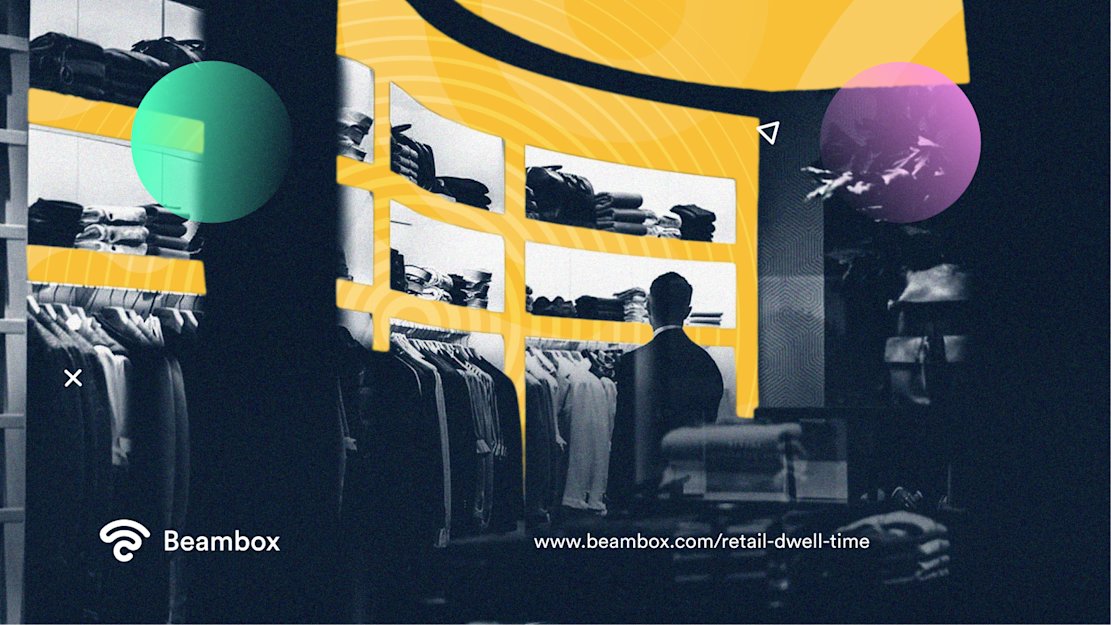Retail Dwell Time That Leads To Increase in Sales
Retail dwell time is a key factor in the retail world.
For one, it measures customer time in a store or shopping center. Longer dwell times increase the likelihood of a sale as customers have more time to browse and consider products.
Also, understanding how dwell time affects retail sales help business owners make intelligent choices. Their options improve the customer experience and increase revenue. Making wise choices involves analyzing data, recognizing patterns, and changing store operations to drive sales.
If you’re a retail business owner, your goal would be to extend dwell time. To do that, you can enhance the shopping experience by making the environment comfortable and inviting. You can also incorporate interactive displays and offer in-store promotions.
In other words, nothing short of providing top-notch customer service.
Retail Dwell Time—What Is Dwell Time Really?

What is dwell time? It’s the amount of time people spend in a location.
Retail dwell time is an important indicator of customer engagement in business. It can significantly impact the likelihood of a customer making a purchase.
Retailers measure foot traffic and the time visitors spend in their stores to study their marketing activities. How business owners layout their stores, matching product displays, and customer service contribute to customer dwell time. The data helps them understand how these factors affect the amount of time customers spend in a store.
The time customers spend in a store or shopping center tells them what works well and what needs improvement.
For example, if customers stay longer in an area, it indicates a high level of interest in that product category. Future marketing and sales strategies can use this information.
Dwell time is also a valuable metric for shopping centers and malls. It provides insight into the overall customer journey and how well the center performs.
Shopping centers can use dwell time data to identify trends, such as which stores attract the most customers. It also tells which areas of the center are most popular. They can use this information to optimize the layout of the center.
Average Dwell Time in Retail—Why Is It Important To Note
There are several reasons why the average dwell time in retail is important to note. Each of these reasons points to retail dwell time as a valuable tool for enhancing marketing activities.
-
Customer engagement: Long dwell hours show customers enjoy spending time in the store. It usually signifies customer engagement and interest in products and services.
-
Sales potential: Customers who stay longer are more likely to buy. Tracking shoppers’ dwell time helps retailers identify opportunities to increase sales and maximize revenue.
-
Store design and layout: The average dwell time can provide valuable insight into the effectiveness of a store’s layout. High dwell time in some store areas may show good design, while low dwell time may indicate areas for improvement.
-
Customer experience: We can use dwell time to measure the overall customer experience. A high dwell time indicates customers have a good store experience, while a low dwell time shows areas for improvement.
-
Marketing effectiveness: Business owners can use dwell time data to track the effectiveness of their marketing efforts. A higher dwell time may signal that your marketing campaign resonates well with the customer.
-
Competition analysis: Business owners can use the data to compare their stores to competitors and identify areas for improvement.
As you can see, tracking retail dwell time is essential for business owners. It helps them assess operations and make informed marketing, sales, and customer experience decisions. Using this data can help retailers stay ahead of the competition.

How Does Dwell Time Affect Retail
As we’ve seen in the previous section, dwell time metrics affect your store’s performance. So, how does dwell time affect retail? Let’s take a closer look.
Longer retails dwell time spent in a store means customers can browse and consider their product range. They can’t be that far from making a purchase.
Aside from that, lingering a little longer allows customers to form a positive impression of the store and its offerings. This impression can lead to increased customer loyalty.
A welcoming and comfortable shopping environment, interactive displays, in-store events and promotions, and exceptional customer service can boost that further.
In contrast, a shorter dwell time indicates low customer satisfaction. This reaction invariably relates to a decreased likelihood of making a sale. A cluttered store layout, long lines at the checkout, and poor in-store customer service contribute to shorter dwell time.
Retailers must address these issues and improve customer satisfaction. Customer relations management using your WiFi is one way to do it. It will increase the time shoppers stay in the store to boost retail sales.
It’s also worth mentioning that external factors can influence shopper dwell time metrics. Weather conditions, time of day, and the surrounding area can impact consumer behavior. Store owners can analyze dwell time data to understand these factors’ impact and adjust their operations accordingly.
Retail dwell time is a crucial metric for business owners. They must strive to create a welcoming and enjoyable shopping environment. Awareness will also guide retailers to address any factors contributing to shorter dwell times. By understanding and optimizing dwell time, retailers can improve their bottom line.
4 Steps in Conducting Retail Dwell Time Analysis
Retail dwell time analysis involves measuring and analyzing the time customers spend in a retail store or shopping center. Here are some steps required to conduct such an analysis:
-
Data collection: The first step is to collect data on the amount of time customers spend in the store. Various methods, such as security cameras, WiFi tracking, and foot traffic counters, can produce this data.
-
Data analysis: Once the data is collected, we can analyze it now. You can determine the average dwell time, peak periods, and areas with high and low dwell times. You can analyze this data either manually or with the help of software tools.
-
Identifying trends and patterns: Analyzing the data guides store owners to identify trends and patterns in customer behavior. For example, they may find that customers spend more time in certain areas or during specific times of the day.
-
Identifying areas for improvement: Understanding the factors that influence dwell time helps retailers identify areas for improvement. These improvements may involve changing the store layout, improving customer service, or offering promotions and events.
Retail dwell time analysis may sound daunting. It is simple once you follow the above steps. Remember, analyzing dwell time is valuable for you as a retailer. It provides you insights into the customer experience and store operations.

8 Important Metrics for Retail Dwell Time Analytics
Retail dwell time analytics involve measuring various metrics to gain insights into customer behavior and store operations. Here are some of the essential metrics:
-
Average dwell time: This metric measures customers’ average time in a store. Average dwell time determines the overall effectiveness of the store and areas for improvement.
-
Peak periods: This measures the times of day or week with the highest customer traffic and dwell time. Use this information to optimize staffing levels and ensure sufficient resources during peak periods.
-
Customer traffic patterns: Measures the flow of customers through the store and identifies areas with high and low customer traffic. Retailers can use it to optimize store layout and improve the shopping experience.
-
Customer journey mapping: This metric tracks customers’ store journey, including time spent in each area.
-
Walk-in rate: The percentage of customers entering a store and becoming potential customers. We calculate this rate by dividing the number of customers entering by those walking by the store. It helps business owners gauge marketing and advertising effectiveness and the store’s overall appeal.
-
Capture rate: The percentage of customers entering a store and making purchases. We compute this by dividing the number of purchases by the number of customers entering the store. Helps retailers assess store operations, including layout, products, and customer service.
-
Conversion rate: The conversion rate is like the capture rate but includes online and mobile sales. It gives a complete view of the store’s overall effectiveness, including in-store and online sales.
-
Sales per square foot: This metric measures the number of sales generated per square foot of retail space.
Metrics in retail dwell time analytics are key to understanding customer behaviors and store operations. Measuring and analyzing them helps store owners make data-driven decisions for better customer experience and sales.
Tools for Retail Dwell Time Analytics
We need tools to measure and analyze customer behavior for effective retail dwell time analysis. Common tools include:
-
WiFi tracking systems: These systems track customer movement in-store using device WiFi signals to determine traffic patterns and hotspots. You can also use WiFi to boost customer engagement while you’re at it.
-
Foot traffic counters: Physical devices placed at store entrances or exits to count customers passing through. We calculate average dwell time and customer traffic patterns using the data collected here.
-
Heat mapping software: Software creates a visual representation of customer movements using data from WiFi tracking or foot traffic counters. Retail operators can identify high or low dwell time areas and customer traffic patterns using this information.
-
Data analysis software: This software analyzes data from WiFi tracking, foot traffic counters, and other sources. We use the data to calculate average dwell time, identify consumer behavior trends, and improve store operations.
Retail dwell time analysis needs tools to measure customer behavior in stores effectively. These tools help retailers improve sales through informed decisions.
Business owners should choose suitable, budget-friendly tools and use them in combination. These tools will help them understand consumer behavior and dwell time comprehensively.
Increase Retail Dwell Time To Increase Sales

“Increased dwell time equals increased sales” cannot be stated enough. So how can business owners increase retail dwell time to increase sales?
Strategies to increase dwell time and drive retail sales include:
-
Enhance the customer experience: Store owners can create a welcoming and engaging environment. They can incorporate technology such as interactive displays and digital signage. They can also offer personalized recommendations, product demonstrations, and in-store events to enhance the shopping experience.
-
Optimize store layout and product displays: These can encourage customers to explore and interact with products. This action includes arranging matching products appealingly. Another option is creating focal points that draw customers’ attention to a store’s essential product range.
-
Offer additional services: Having in-store cafes, lounges, and changing rooms create a more enjoyable environment for customers. Retail operators can use these services to extend dwell time and increase sales.
-
Provide high-quality customer service: Retailers can train their staff to provide high-quality customer service. Training areas include offering assistance, answering questions, and providing product recommendations. These encourage customers to spend more time in the store.
In conclusion, we can increase dwell time by enhancing the customer experience and optimizing store layouts or product displays. Offer other services and provide high-quality customer service. Implement dwell time data analysis for informed decisions. Focus on these strategies to increase dwell time, drive sales, and improve profits.
Integrating Retail Dwell Time Analysis With Marketing Software
As you can see, retail dwell time analysis is a powerful tool for building your brand. You can boost this further by integrating marketing software that fits your needs.
Marketing software can utilize the data collected from dwell time analytics to target and personalize marketing campaigns.
Marketing campaigns targeting specific customers help improve overall customer experience and drive sales.
Additionally, marketing software can provide additional insights and analysis. Customer demographics and purchasing behavior are crucial to informed decisions and optimized operations.
Integrating marketing software with retail dwell time analysis improves coherence and drives long-term results, enhancing overall marketing effectiveness.
Beambox’s digital marketing solution can help you get the most out of reviews, contact lists, and customer information. Along with dwell time analytics, it can help you plan, monitor, and redirect your marketing efforts to grow your business.
Learn more about Beambox and start growing your business now.
Get Started With Free WiFi Marketing
Beambox helps businesses like yours grow with data capture, marketing automation and reputation management.
Sign up for 30 days free


